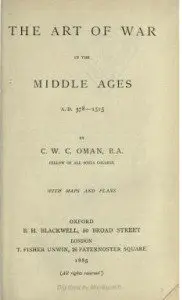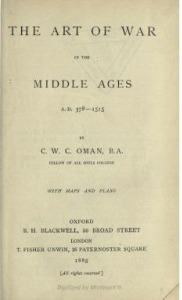Sir Charles William Chadwick Oman, The art of war in the Middle Ages, A.D. 378-1515
Oxford University | 1885 | 1st edition | 164 pages | PDF | 14 MB
Oxford University | 1885 | 1st edition | 164 pages | PDF | 14 MB
With maps and plans.
Contents.
Introduction I
Chapter I. The transition from Roman to mediaeval forms in war (A.D. 378-582).
Disappearance of the Legion. Constantine's reorganization. The German tribes. Battle of Adrianople. Theodosius accepts its teaching. Vegetius and the army at the end of the fourth century. The Goths and the Huns. Army of the Eastern Empire. Cavalry all-important
Chapter II. The Early Middle Ages (A.D. 476-1066).
Paucity of Data for the period. The Franks in the sixth century. Battle of Tours. Armies of Charles the Great. The Franks become horsemen. The Northman and the Magyar. Rise of Feudalism. The Anglo-Saxons and their wars. The Danes and the Fyrd. Military importance of the Thegnhood. The House- Carles. Battle of Hastings. Battle of Durazzo.
Chapter III. The Byzantines and Their Enemies (A.D. 582-1071).
1. Character of Byzantine Strategy.
Excellence of the Byzantine Army. Scientific study of the art of war. Leo's ' Tactica.' Wars with the Frank. With the Turk. With the Slav. With the Saracen. Border warfare of Christendom and Islam. Defence of the Anatolic Themes. Cavalry as a defensive force. Professional and unchivalrous character of Byzantine officers
2. Arms, Organization, and Tactics of the Byzantines.
Reorganization of the Army of the Eastern Empire by Maurice. Its composition. Armament of the Horseman, A.D. 600-looo. Armament of the Infantry. Military Train and Engineers. The Officers. Cavalry tactics. Leo's ideal line of battle. Military Machines and their importance
Chapter IV. The Supremacy of Feudal Cavalry (A.D. 1066-1346).
Unscientific nature of feudal warfare. Consequences of headlong charges. Tactical arrangements. Their primitive nature. Non-existence of strategy. Weakness of Infantry. Attempts to introduce discipline. Rise of Mercenaries. Supreme importance of fortified places. Ascendency of the defensive. The Mediaeval siege. Improvement of the Arts of Attack and Defence of fortified places. General character. The Crusades
Chapter V. The Swiss (A.D. 1315-1515).
1. Their Character, Arms, and Organization.
The Swiss and the Ancient Romans. Excellence of system more important than excellence of generals. The column of pikemen. The halberdier. Rapidity of the movements of the Swiss. Defensive armour. Character of Swiss armies
2. Tactics and Strategy.
The 'Captains' of the Confederates. The Echelon of three columns. The 'Wedge' and the 'Hedgehog' formations
3. Development of Swiss Military Supremacy.
Battle of Morgarten. Battle of Laupen. Battle of Sempach. Battle of Arbedo. Moral ascendency of the Swiss. Battle of Granson. Battle of Morat. Wars of the last years of the fifteenth century
4. Causes of the Decline of Swiss Ascendency.
The tactics of the Swiss become stereotyped. The Lands-knechts and their rivalry with the Swiss. The Spanish Infantry and the short sword. Battle of Ravenna. Fortified Positions. Battle of Bicocca. Increased use of Artillery. Battle of Marignano. Decay of discipline in the Swiss
Armies and its consequences
Chapter VI. The English and Their Enemies (A.D. 1272-1485).
The Long-bow and its origin, Welsh rather than Norman. Its rivalry with the Cross-bow. Edward I and the Battle of Falkirk. The bow and the pike. Battle of Bannockburn and its lessons. The_French Knighthood and the English Archery. Battle of Cressy Battle of Poictiers. Du Guesclin and the English reverses. Battle of Agincourt. The French wars, 1415-1453. Battle of Formigny. Wars of the Roses. King Edward IV and his generalship. Barnet and Tewkesbury. Towton and Ferrybridge.
Chapter VII. Conclusion.
Zisca and the Hussites. The Waggon-fortress and the tactics depending on it. Ascendency and decline of the Hussites. Battle of Lipan. The Ottomans. Organization and equipment of the Janissaries. The Timariot cavalry. The other nations of Europe. Concluding remarks.



